6 Common Types of Auto Window Tinting & Their Benefits
The auto window tint needs vary from one place to another and depend mostly on the kind of climate in your area. For people who live in the Kansas metro area they know the summer sun can be unbearable. However, all tinting films must provide minimum protection against the sun, even if you live in a cold region where the sun is rarely out. There are so many types of window films to choose from that it can be quite confusing. At the most basic level there are 6 different types and knowing the benefits of each one can help you make the right choice.
1. Dyed Window Tinting
If you are on a budget, this can be the perfect choice of Auto Window Tinting for you. They are relatively inexpensive and block sunlight using multiple layers of dye. The dye absorbs solar heat and prevents some of the heat from entering your vehicle. However, this type of film doesn’t provide the level of protection offered by other types of films.
It has an opaque appearance that makes it a good choice for increasing privacy. Dyed Auto Window Tint will fade over time and needs to be replaced. They provide some level of heat reduction but it is not as high as other counterparts.
2. Metalized Window Tinting
Similar to dyed films, metalized Auto Window Tinting also helps in filtering out heat by reflecting it. But these films make use of tiny metallic particles to block sunlight instead of using dye. These particles are almost invisible and are embedded within the film.
This type of film provides another kind of protection – it adds to the window’s strength. The shatter-resistance will increase significantly when metalized film is installed over the windows. This type of film can be recognized by its shine. It has higher scratch-resistance compared to dyedAuto Window Tinting.
The main advantages of metalized window films include the following:
- Highly effective in blocking out heat.
- Effective glare reduction.
- Efficient UV blocking.
Metalized window tinting is durable and can last for a longer time without fading.
3. Hybrid Window Tinting
These types of Auto Window Tinting films have both metallic particles and dye. Hybrid films provide the positive effects of both while reducing their negatives. A commonly used combination is titanium and grey dye. This combination is neither too dark nor too reflective or mirror-like. Thus, the film is decently bright and not too reflective, providing some privacy while blocking a good percentage of heat and UV rays.
4. Carbon Window Tint Film
This type of Auto Window Tinting provides many advantages over other types of tint films. It has a unique matte-finish that makes it attractive. Its carbon content helps in blocking around 40% of the IR radiations responsible for heating the interiors. This not only helps keep the vehicle’s interiors cool, it also prevents or slows down upholstery fading.
This type of tint film helps in saving energy by reducing the need for cooling during summer and heating during winter. Carbon film is also durable and doesn’t fade like dyed tinting.
5. Crystalline Tinting
Many people want to tint their vehicle’s windows without making them dark. If that’s your goal, you should use crystalline window tint. It will block ultraviolet radiations and solar heat without the need for a dark film. It will seem that there is no tinting at all.
6. Ceramic Window Tinting
If you are looking for high quality Auto Window Tinting, ceramic tint films can be the perfect option. It contains ceramic particles known for their non conductive properties. A relatively new type of tinting, it is expensive yet proven for its performance. It can block up to 50% of solar heat without blocking visibility. While metallic tinting offers similar benefits, it can affect the functioning of electronic equipments because it blocks signals. Ceramic films provide an effective and efficient alternative.
Some of the main benefits of ceramic Auto Window Tinting include the following:
- Strong resistance to fading and glare.
- Increases shatter resistance.
- Blocks out UV rays effectively.
Ceramic tint films can block up to 99% of UV rays from entering your vehicle’s interiors, thus protecting against its harmful effects.
These are the 6 most widely used

